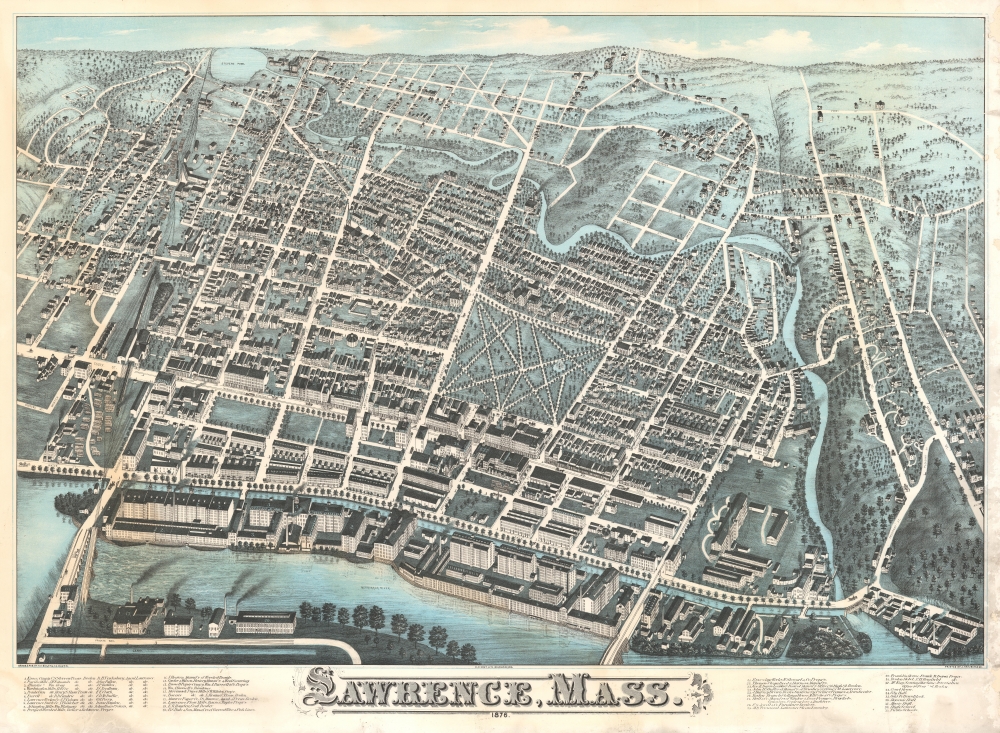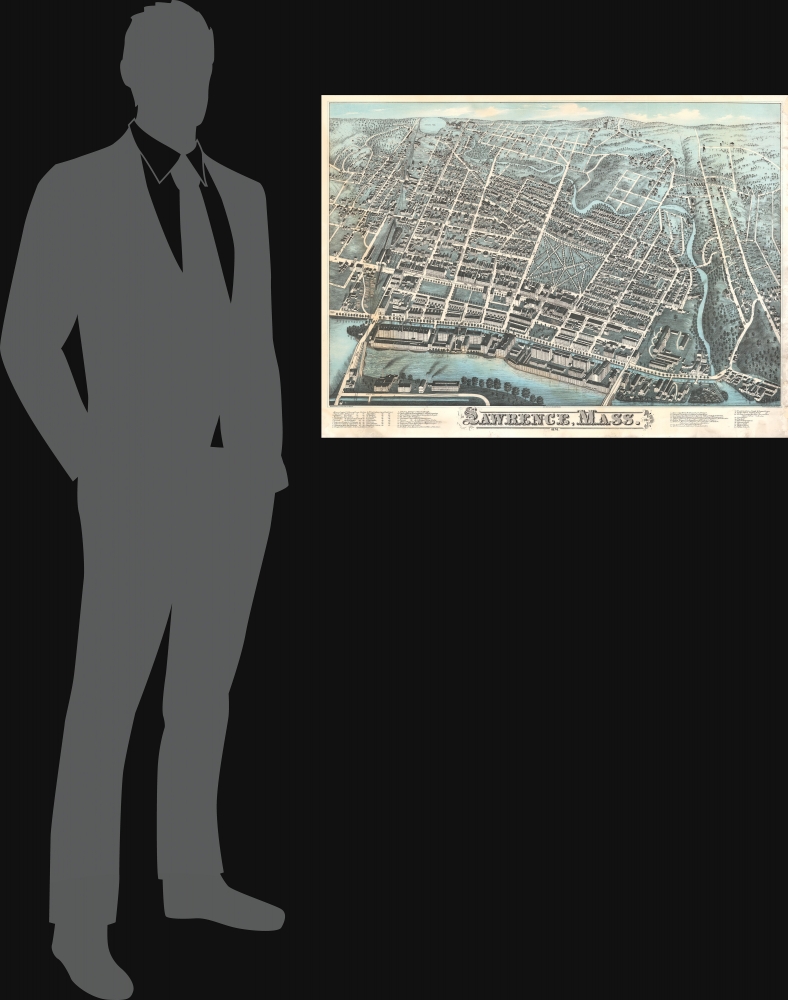1878 Bailey and Hazen View of Lawrence, Massachusetts
LawrenceMass-baileyhazen-1876
Title
1876 (dated) 23 x 31.50 in (58.42 x 80.01 cm)
Description
A Closer Look
The north-oriented view embraces Lawrence from Steven's Pond to the Merrimack River. Bailey's distinctive high-oblique perspective gives the view a notable map-like quality. The orientation and perspective focus attention on the bustling city's sprawling textile mill infrastructure laid out along the Merrimack River. Some 39 businesses are numbered and keyed to table below the view, including municipal buildings, schools, mills, the residences of noted individuals, and factories.Lawrence: Textile City
Lawrence was named after Abbott Lawrence, a Boston financier. Lawrence chose the site as the manufacturing hub of the Essex Company, a major textile concern, due to the abundant waterpower provided by Bodwell Falls (at far left). The town incorporated by 1847 and within a decade transformed from a rural town to a major industrial center, driven by the Essex Company's large-scale manufacturing - depicted here along the riverfront. The city's mills attracted waves of European immigrants, including Irish, Germans, Italians, Poles, and Lebanese, enriching its cultural tapestry. Despite the industrial boom, mill workers contended with challenging conditions, leading to the pivotal Bread and Roses Strike of 1912 that spotlighted the need for labor reforms. By the century's end, Lawrence was not only an industrial powerhouse but also a testament to the resilience and aspirations of its diverse populace. The Lawrence textile industry began a sharp decline in the early 20th century due to economic shifts, aging infrastructure, and the Great Depression. Today most of the old mills have been repurposed as residential buildings, art spaces, offices, and mixed-use facilities.American Bird's-Eye City Views
The tradition of the bird's-eye city view emerged in the United States in the middle part of the 19th century and coincided with the commercial development of lithographic printing. Before the rise of lithography, the ability to own and display artwork in the home was largely limited to the extremely wealthy, the advent of lithographic printing made it possible for everyone to own visually striking artwork. A robust trade developed in portraits of political leaders, allegorical and religious images, and city views.City views were being produced in the United States as early as the 1830s, but the genre exploded after the American Civil War (1861 - 1865). Bridging the gap between maps and pictures, most 19th century American bird's-eye views presented cities to the public from high vantage points. Some were imagined, but others were drawn from hot-air balloons or nearby hills. The presentation, combining high elevation, commercial interest, and new printing technology, created a uniquely American art form, as described by historian Donald Karshan,
Some print connoisseurs believe that it was only with the advent of the full-blown city-view lithograph that American printmaking reached its first plateau of originality, making a historical contribution to the graphic arts. They cite the differences between the European city-view prints and the expansive American version that reflects a new land and a new attitude toward the land.The vogue for bird's-eye city views lasted from about 1845 to 1920, during which period some 2,400 cities were thus portrayed, some multiple times. Although views were produced in many urban centers, the nexus of view production in the United States was Milwaukee, Wisconsin. The major American viewmakers were Stoner, Wellge, Bailey, Fowler, Hill, Ruger, Koch, Burleigh, Norris, and Morse, among others.
Chromolithography
Chromolithography, sometimes called oleography, is a color lithographic technique developed in the mid-19th century. The process involved using multiple lithographic stones, one for each color, to yield a rich composite effect. Oftentimes, the process would start with a black basecoat upon which subsequent colors were layered. Some chromolithographs used 30 or more separate lithographic stones to achieve the desired product. Chromolithograph color could also be effectively blended for even more dramatic results. The process became extremely popular in the late 19th and early 20th centuries when it emerged as the dominant method of color printing. The vivid color chromolithography produced made it exceptionally effective for advertising and propaganda imagery.Publication History and Census
This view was drawn by Howard Heston Bailey and James Compton Hazen. It was published and printed in Milwaukee, Wisconsin, by Charles H. Vogt and Jacob Knauber. Reps notes examples at the Boston Public Library and the Merrimack Valley Textile Museum. We note additional examples at the University of Michigan Clements Library, the Huntington Library, and Massachusetts State Library. Scarce on the private market.CartographerS
Howard Heston Bailey (1836 - 1878) was an American calligrapher and artist. Born in Ohio, Bailey began his career as a calligrapher, selling business cards and illustrated advertisements to businesses across the Midwest. At some point in the late 1860s, Bailey met T.M. Fowler (1842 - 1922), who may have been working for Albert Ruger. Bailey and Fowler must have become close friends and Fowler's daughter even asserted that Bailey 'taught her father how to draw' city views. In 1870, Bailey entered the world of view making, publishing nine impressive bird's eye views of places in central and southern Wisconsin, at least one of which was published by Fowler. The following year, another twenty-two city views appeared with his name on them as either the artist or publisher, with Fowler publishing at least eight of them by himself or in partnership with Bailey. 1872 was another productive year for Bailey, who published a view of Milwaukee that year, along with a view of Columbus, Ohio, on which he collaborated with his brother Oakley Hoopes Bailey (1843 - 1947). The publishing firm Fowler and Bailey first appeared in 1872 as well, making it impossible to know exactly who, and in what combination, the two Baileys and Fowler drew and published views bearing that imprint. The trio moved to Ithaca, New York in 1873, and all three men remained busy, drawing and publishing views under various different imprints. In 1874, H. H. Bailey published a view of Poughkeepsie with James Compton Hazen (1852 - 1908), who had been his subscription agent in Syracuse the previous fall. Hazen spent the next four years working with Bailey. Fowler and Bailey went their separate ways in 1875, publishing thereafter under the names H. H. Bailey and Co. or H. H. Bailey and J. C. Hazen. Over the course of his career as a viewmaker, Bailey published seventy-two views, not including those published under the Fowler and Bailey imprint, on which he must have worked. According to John W. Reps, 'No viewmaker surpassed H. H. Bailey in his careful representation of industrial and business districts.' More by this mapmaker...
James Compton Hazen (November 5, 1852 - January 14, 1908) was an American landscape artist and viewmaker active in the late 19th and early 20th centuries. Hazen was born in Hackettstown, New Jersey. Hazen began working with the viewmaker Howard Heston Bailey (1836 - 1878) as early as 1873. His work seems to have been broad ranging, including actually drafting the views, as well as door to door sales, and even delivery of the final product. From 1877 he worked with H. H. Bailey's younger borther, Oakley Hoopes Bailey (1843 - 1947), where he completed some of his most famous work, including important views of Boston and Hew Haven. Hazen's name is associated with some 55 views, the last of which, Lynn Woods, was completed in 1904. He died four years later in 1908 and is interred near his birthplace in Morristown, New Jersey. Learn More...
Charles H. Vogt (1823 - 1895) was a Prussian-American lithographer active in Cleveland, Ohio from about 1870 to 1889. Vogt was born Prussia and immigrated to the United States in c. 1860, settling in Iowa. He was established as a lithographer of American city views Davenport, Iowa during the 1860s, then in Milwaukee from 1870 to 1879, then in Cleveland, Ohio, from 1879 to 1889. Vogt worked with his son, Gustav. H. Vogt (c. 1858 - July 12, 1936). Learn More...
Jacob Knauber (1846 – 1905) was a German-American lithographer based in Milwaukee, Wisconsin. Knauber was born in Heidelberg, Germany and emigrated to America as a young man. He apprenticed as a lithographer in St. Louis from 1861. In 1867 he foundered J. Knauber Lithographing Company, which he would eventually run with his three sons, Arthur, Walter, and Richard. The firm specialized in American city views, billheads, letterheads, receipts, and checks. Knauber managed the firm it until his death in 1905. Afterwards it was run by his children until 1946 when it was acquired by Columbia Art Works. Learn More...




